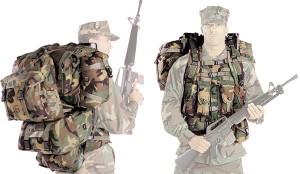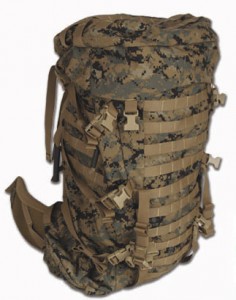Most people won’t ever think about it, but U.S. military backpacks represent years and years of development, testing and heavy use in the field. From World War 1 and 2 to more modern conflicts, the military has been working to equip their soldiers with the best possible equipment available. From the roots of WW1 & 2, the modern military backpack has evolved. This eveolution has been a steady progression, where newer, more modern materials have moved things forward in ways that were unavailable at any time before.
M-1956 Load-Carrying Equipment
The M-1956 Load-Carrying Equipment (LCE) was the first major redesign of load-carrying equipment for soldiers of the U. S. Armed Forces since the M-1928 field pack, which differed in only minor details from the M-1910 field pack. Although the M-1956 LCE differed considerably from its predecessor, it was made from the same materials as previous designs and retained the use of belt, suspenders and carrying pack.
The LCE consisted of equipment belt, suspenders for carrying load, field pack, entrenching tool carrier, ammunition cases, canteen cover, pouch containing first aid, and sleeping bag carrier. The LCE was made of cotton canvas webbing like earlier equipment, yet introduced sliding clip fasteners that replaced the wire hooks dating back to the M-1910 design. The LCE was considered lightweight for its time due to the small size of the field pack; however, soldiers found the field pack insufficient for more than a day’s needs and often augmented their kit with a second or larger pack. This lead to the development of a slightly larger pack with a rounded shape, the M-1961 Rucksack.
Between the LCE and the Army’s next major revision in 1967, a series of interim experiments were conducted using lighter materials. In 1962, tests on a nylon-constructed set of LCE revealed a substantial reduction in weight—nearly two pounds. In addition, the 1962 Lightweight Rucksack, also made of nylon, weighed less than cotton duck versions. These two pieces of equipment—the LCE and the 1962 Lightweight Rucksack—formed the nucleus of the Army’s next redesign effort.
M-1967 Modernized Load-Carrying Equipment
The Lightweight Individual Clothing & Equipment (LINCLOE) program of 1965 marked the official start of a nine-year program by the U. S. Army to develop a standard load-carrying equipment system for soldiers. The LINCLOE program applied a ‘systems analysis’ approach to redesigning load-carrying gear. The results of the 1962 experiments with nylon materials were incorporated into the LINCLOE program.
In response to the need for load-carrying gear that was more suitable to the tropical climate of Vietnam, LINCLOE developed the M-1967 Modernized Load-Carrying Equipment (MLCE). The M-1967 MLCE was basically an M-1956 LCE made with different materials that were more appropriate for use in tropical environments. During the early part of the Vietnam War, environmental conditions in Southeast Asia exposed the shortcomings in the webbing, cotton duck and canvas of the LCE. Cotton absorbed water thereby increasing weight; in addition, cotton duck, canvas and webbing were adversely affected by mildew and dry rot.
The MLCE uses the same basic components as the LCE, but replaces cotton with nylon, and steel and brass with aluminum and plastic. Nylon was lightweight, fast-drying, abrasion-resistant and not affected by mildew.
Velcro fasteners, also called “hook and pile” fasteners, replaced the LTD fasteners and zippers of the LCE. MLCE and LCE components were interchangeable and mixed configurations were common in soldier’s kits.
Although the MLCE was intended only for tropical use, the characteristics of nylon impressed LINCLOE designers who considered adopting the MLCE as standard issue. Instead, an even more extensive revision of load-carrying equipment was deemed necessary and led to the next phase of the LINCLOE program.
Development of the ALICE military backpack
In addition to the MLCE, the LINCLOE program developed another set of load-carrying equipment, the LINCLOE LCE, which was introduced in 1969. During 1970-72, combined configurations of the LINCLOE LCE and the MLCE were tested. However, in March 1972 the U. S. Army suspended testing due to a number of problems with the sets of equipment provided by Natick Laboratories. After these problems were corrected, testing was resumed and completed by August 1972. In November 1972, the LINCLOE project submitted its final report recommending no further testing or development for the load-carrying equipment system.
After the U. S. Army and Natick Laboratories agreed on a unified LCE system, the M-1972 Lightweight Load-Carrying Equipment (LLCE) was adopted as standard issue in January 1973. In 1974, the M-1972 LLCE was re-designated the All-Purpose Lightweight Individual Carrying Equipment (ALICE).
One of the primary design goals of the ALICE was to reduce weight on the individual soldier. The ALICE system was relatively successful at doing this.
The concept of existence and fighting loads is fundamental to the ALICE system. The fighting load, such as weapons and ammunition, is distributed on the belt and suspenders while the existence load, such as food supplies, is intended to be carried in the field pack.
The ALICE system is no longer used by active units in the U. S. Armed Forces; however, ALICE packs may still be used for training.
Individual Integrated Fighting System (IIFS)
The Army began testing a new system to replace the ALICE in the 1980s. This effort produced the Individual Integrated Fighting System (IIFS), introduced in 1988. The IIFS has three components: the tactical load-carrying vest, a modified version of the M-1967 MLCE field pack that was later designated the Combat Field Pack M-1990 (CFP-90), and a smaller Combat Patrol Pack.
In the IIFS, the fighting loads are carried on the vest and in the Combat Patrol Pack; existence loads are carried in the Combat Field Pack.
The IIFS vest borrowed from previous designs by Natick Labs that were used by Vietnam-era Navy SEALS. Reflecting the military’s continued interest in finding a practical balance between armor and load-bearing equipment, prototypes of the tactical vest used Kevlar, but this was rejected for being too heavy. Field usage of the vest revealed that it was poorly ventilated, so it was redesigned in the 1990s. It has since been re-named the Enhanced Tactical Load-Bearing Vest (ETLBV).
The CFP-90 is a top-loading pack constructed of water-repellent back-coated nylon fabric and an internal frame of two removable aluminum staves. The pack has two compartments: a main compartment with a false bottom and an internal compartment for communications equipment or a hydration unit. There are also holes for the hydration tube or radio antenna, three outer pockets and webbing on the pack that allows for additional equipment to be attached.
The smaller Combat Patrol Pack carries part of the fighting load and is attached to the top of the larger CFP-90 field pack.
Although IIFS was issued to U. S. Armed Forces during the early and mid-1990s, it was never officially declared the replacement for the ALICE. Instead, the U. S. Army began another design program that eventually produced the MOLLE. The IIFS seems to have never been entirely removed from service. For example, both the ETLBV and the CFP-90 were used by troops in the field in Afghanistan.
Modular Lightweight Load-carrying Equipment (MOLLE)
Modular Lightweight Load-carrying Equipment, known as MOLLE, is the current standard-issue military backpack for the U. S. Army. It is produced by three companies: Eagle Industries. Specialty Defense and Armor Holdings.
MOLLE quick-release backpacks officially replaced the ALICE pack as the military standard for Individual Load-Carrying Equipment (ILCE). The MOLLE was introduced in 1997 and initially adopted by both the U. S. Army and the U. S. Marine Corps; however, the Marine Corps found the MOLLE unsatisfactory and initiated their own development program that produced the Improved Load Bearing Equipment (ILBE) system.
 The design roots of the MOLLE included a survey of U. S. soldiers in 1996 that was used to identify the design goals for a new military backpack that would replace the aging ALICE and the IIFS.
The design roots of the MOLLE included a survey of U. S. soldiers in 1996 that was used to identify the design goals for a new military backpack that would replace the aging ALICE and the IIFS.
The MOLLE differs considerably from antecedent systems by its use of a modular attachment system patented by the U. S. Army Natick Soldier Center called the Pouch Attachment Ladder System (PALS). PALS consists of a series of evenly spaced horizontal rows made of heavy-duty nylon webbing sewn onto the load-bearing equipment. The PALS system has since become the preferred method of attachment for state-of-the-art military tactical gear.
Smaller attachments, such as knife sheaths, holsters or other containers equipped with PALS webbing can easily be attached to the MOLLE. This allows soldiers to customize their field pack to a considerable extent to meet a variety of mission-specific needs. Different configurations for the MOLLE include grenadier, rifleman, Squad Assault Weapon gunner and medic.
There are three components to the MOLLE system: The Fighting Load Carrier (FLC), the Modular Pouches, and the Hydration Bladder.
The Fighting Load Carrier, also called the Load-Bearing Vest (LBV), is able to accommodate more ammunition than the load-bearing equipment and suspenders of the ALICE system. The FLC uses no metal clips and utilizes an H-harness on the back for better ventilation. Fatigue is mitigated by a connecting device between the load-bearing vest and the main rucksack that transfers the carrying load on the shoulders to the hips.
Unlike the tubular frame of the ALICE pack, the MOLLE uses a durable anatomically-contoured pack frame made with plastic developed for automobile bumpers. Another improvement over the ALICE system is that the waist belt can be adjusted to accommodate torsos of different sizes. Stored underneath the rucksack is the Army’s new modular sleeping bag that uses a system of layers that can be deployed as needed for cold weather. Detachable pouches on either side of the main pack hold a Meal, Ready-to-Eat (MRE) and a tube from the hydration unit delivers water.
The MOLLE pack has seen extensive service in Iraq and Afghanistan since 2001. However, soldiers in the field voiced criticisms of certain aspects of the MOLLE design. For example, the external plastic frame of the main pack was prone to breakdown under field conditions and a number of lower back injuries were attributed to the ball-and-socket mechanism between the frame and waist-belt. In addition, the straps were too short to accommodate body armor.
These shortcomings have since been remedied in revised versions of the MOLLE, designated as MOLLE II. Among the changes in MOLLE II are: the elimination of the ball-and-socket mechanism, which is replaced with a quick-release mechanism using a waist-belt permanently affixed to the pack frame; the Load-Bearing Vest (LBV) was redesigned without the molded waist-belt or the quick-release frame of the original LBV; the butt pack of the MOLLE was redesigned as a waist pack for MOLLE II; and the MOLLE II packs feature a Canteen Carrier/Utility not found on previous versions.
Improved Load Bearing Equipment (ILBE)
Developed specifically to meet the needs of the U. S. Marine Corps, the Improved Load Bearing Equipment (ILBE) military backpack was developed after feedback from Marines in the field during the Second Gulf War. The Marine Corps specifically requested a backpack with reduced volume, greater load-carrying capability, less complexity than the MOLLE, and the ability to carry 60mm and 81mm mortar rounds on the outside of the pack. The ILBE was approved by the U. S. Marine Corps in 2004 and is the current standard-issue backpack for Marines.
 The ILBE was designed by Arc’teryx, a company that originated in Canada, as part of the Law Enforcement and Armed Forces (LEAF) program. The ILBE contains three components: the ILBE Main Pack, the ILBE Assault Pack, and the ILBE Hydration System.
The ILBE was designed by Arc’teryx, a company that originated in Canada, as part of the Law Enforcement and Armed Forces (LEAF) program. The ILBE contains three components: the ILBE Main Pack, the ILBE Assault Pack, and the ILBE Hydration System.
The Main Pack carries the main load of the ILBE three-part system. Made of Cordura 725, the pack is also fitted with PALS grids for MOLLE-type pocket attachments, allowing soldiers to customize their pack. Unique to the ILBE packs is the ability to carry 60mm and 81mm mortar rounds on the outside of the pack.
The Assault Pack carries the main fighting load of ammunition for the ILBE. Equipped with PALS webbing, it is designed to carry up to 40 pounds and consists of two storage compartments in addition to an inner pocket to hold the hydration unit.
The ILBE Hydration System is a bladder-type hydration unit that holds 100 ounces of water.
The ILBE was designed for three specific load configurations to respond to the contingencies faced by Marines in the field: the Existence Load, the Approach March Load and the Assault Configuration.
In the Existence Load configuration, all three components are utilized. This is the heaviest configuration as the soldier carries necessities for extended missions in which re-supply is not possible. A fully loaded ILBE can weigh as much as 120 pounds.
The Approach March Load uses only the ILBE Main Pack and hydration unit and is intended for extended missions away from supply lines.
The Assault Configuration is the lightest of the three configurations and utilizes only the ILBE Assault Pack and hydration unit. This configuration allows for maximum combat effectiveness and mobility.
The ILBE has MARPAT camouflage printed on it. MARPAT (MARine PATtern) is a pixilated camouflage pattern formed by numerous rectangle-shaped colored pixels; it is patented by the U. S. Marine Corps.
In late 2009, the Marine Corps announced that they were looking into a replacement for the ILBE. A 2009 survey of Marines revealed, among other shortcomings, that the ILBE does not integrate well with the Modular Tactical Vest (MTV) body armor that was developed to protect against roadside bombs.
[phpbay]military backpack, 21, “”, “”[/phpbay]
